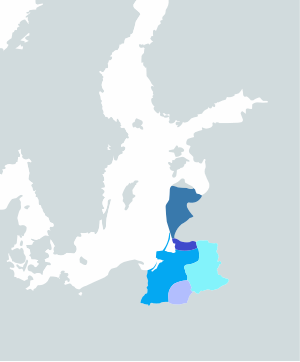lingvo.wikisort.org - Language
The Western Baltic languages were a group of Baltic languages that were spoken by Western Baltic peoples. Western Baltic is one of the two primary branches of Baltic languages, along with Eastern Baltic. It includes Old Prussian, Sudovian, Western Galindian, possibly Skalvian and Old Curonian.[1][2]
| Western Baltic | |
|---|---|
| Geographic distribution | In the northeast of Central Europe, western parts of Baltic region |
| Linguistic classification | Indo-European
|
| Subdivisions |
|
| ISO 639-5 | bat |
| Linguasphere | 54= |
 Former extent of Western Baltic languages (including disputed ones) in 12th century Europe Western Baltic languages Skalvian †
| |
The only properly attested Western Baltic language of which texts are known is Old Prussian, although there are a few short remnants of Old Curonian and Sudovian in the form of isolated words and short phrases.[3] Many Western Baltic languages went extinct in the 16th century while Old Prussian ceased to be spoken in the early 18th century.[4]
History
Western Baltic was presumably native to the north of Central Europe, especially modern Poland, and the western Baltic region, which includes parts of modern Latvia and Lithuania. The Western Baltic branch probably fully separated from Eastern Baltic around the 4th–3rd century BCE, although their differences go as far as the middle of the last millennium BC.[3]
The Western Baltic languages were more archaic. Unlike their Eastern counterparts, Western Balts have retained the dipthong *ei (e. g., deiws 'god', acc. deinan 'day'), palatalized consonants ḱ, ǵ, and compounds tl, dl. They also preserved three genders: masculine, feminine and neuter.[3] Sudovian and Old Curonian shared suffix -ing-, which can be observed in various hydronyms and oeconyms (e. g., Apsingė, Nedzingė, Pilvingis, Suvingis) found in southern Lithuania.
References
- Gimbutas, Marija (1963). The Balts. Ancient peoples and places 33. London: Thames and Hudson. Retrieved 3 December 2011.
- Zinkevičius, Zigmas (January 1, 1996). The History of the Lithuanian Language. Mokslo ir enciklopedijų leidykla. p. 51. ISBN 9785420013632.
- Rytų ir vakarų baltai. Du baltų tarimų junginiai [Eastern and Western Balts. Two Compounds of Baltic Spelling] (in Lithuanian). Mokslo ir enciklopedijų leidybos institutas.
- Young, Steven (2008). Baltic. In Kapović, Mate (ed.). The Indo-European Languages. London: Routledge. pp. 486–518.
Другой контент может иметь иную лицензию. Перед использованием материалов сайта WikiSort.org внимательно изучите правила лицензирования конкретных элементов наполнения сайта.
WikiSort.org - проект по пересортировке и дополнению контента Википедии